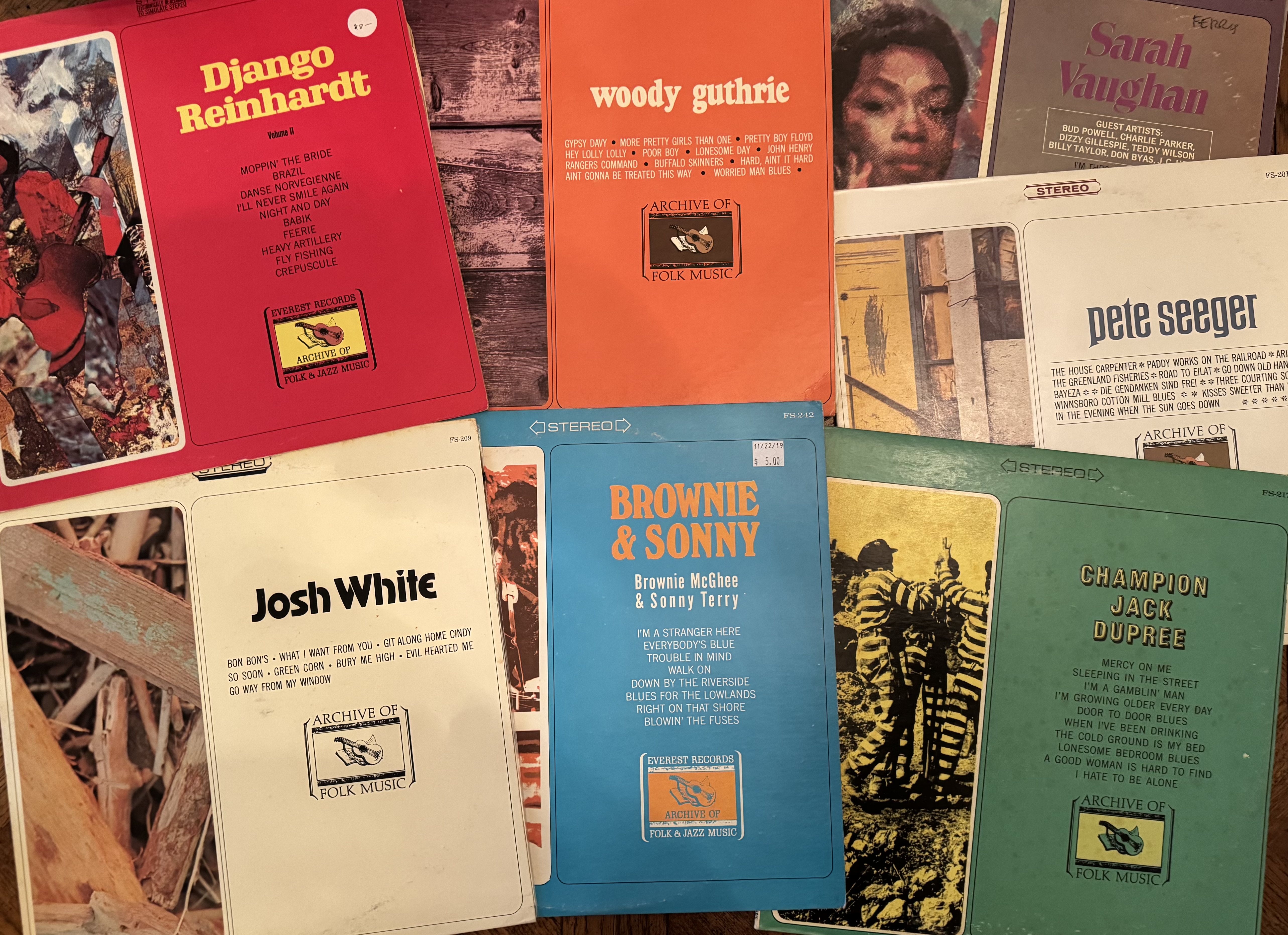
First Anniversary
Published on Dec 17, 2025
Introducing: The IHTOV Zine
Published on Dec 15, 2025
Christmas Music Selections
Published on Dec 14, 2025
The Beastie Boys and Me
Published on Dec 10, 2025
More Liner Notes…
Featured Essay: The Everest Archive of Folk and Jazz and Label Design
by Shaw Ingram

They say not to judge a book by its cover. No one has ever said the same thing about a record. In fact, there’s one specific cover design that will lead me to purchase a record without hearing a note of it, even if I have never heard of the artist in question. Especially if I have never heard the artist in question. It consists of two rounded rectangular sections with a portrait of the artist (or sometimes a landscape or such) on the left, and their name and a tracklist on the right: the Everest Archive of Folk and Jazz series.
The series is not particularly renowned for the fidelity of its recordings, and is sometimes maligned in online comment sections for odd choices regarding the tracks included, but I’ve always found them to be competent surveys of the artists included therein. They are not difficult to find, and are typically priced affordably. They function just as well whether the listener is a fan of the artist, or as a sampler a collector might feel obligated to keep on their shelf for archival purposes. In any case, I’ll buy them every time.
Some of my Everest recordings have gotten many spins over the years (shout out to Huddie Ledbetter aka Leadbelly). For other artists, such as mid-century singer/songwriter Josh White, hearing the Everest release was my first exposure to them. My own tastes lean more towards the folk side, but jazz-heads will be equally pleased with the Everest catalog.
The stable of musicians covered by the Archive is what you might expect, but with enough deviations that it was my introduction to some of these artists, or at least the first record I acquired by them. Some artists receive more attention than others (Four whole volumes of Django Reinhardt!). There are some oddities as well, most notably an LP of recordings by…Little Richard and Jimi Hendrix? Even a cursory listen shows that these are from Hendrix’s days as a working studio musician, and much of his guitar work here sounds more like sketches or placeholder tracks than fully formed musical ideas. Still, it is an interesting piece and does contain a very nice version of “Goodnight Irene” that sees Little Richard eschewing his typical hot rod piano boogie for the lower-tempo motif of a gospel spiritual. I have since found this recording available elsewhere but this was my first exposure to it. It remains a highlight of the LP.
The internet did not immediately offer a clear chronicle of the history of the series or the provenance of its recordings. Wikipedia turns up an entry for “Everest Records” and its legendary, self-taught electrical engineer co-founder Harry Belock. But there’s no mention of the Archive series in the article.
Eventually I found some evidence that these recordings were issued by the same entity: a .pdf on a website hosted by Both Sides Now publications. In this document I found every Everest Archive release listed along with the rest of the Everest Catalog. I realized my beloved series was more of an afterthought - something issued in the waning days of the company, long after its founder had been ousted.
In researching this article, I discovered something else that was interesting: the iconic design that has drawn my eye on record shelves for many years now is not the only layout that Everest has used. According to Discogs the design only appears on about half of the Everest Archive releases. There were other standard designs used over the years, but the “two rectangles” setup is the most common. Ironically, I have probably seen these less common covers over the years, and passed them by, not recognizing them as part of the Archive!
When I set out to write this article, I thought it would be about the history of the Everest Archives series, but that story turned out to be less interesting than I had anticipated. Instead, this writing led me to reflect on the impact that graphic design holds over us as record collectors. It was the uniformity of the Everest Archive cover design that led me to purchase so many of these records over the years. Looking back, I had a similar revelation in the 2000s regarding Sub-Pop’s record label design. My collection was much, much smaller then, but I started to notice multiple artists I enjoyed – Iron and Wine, Blitzen Trapper, The Gutter Twins – all shared the same design on their labels. Of course, I knew a bit about who Sub-Pop were already, but once I noticed these artists I enjoyed were all from their catalog, I started to consider other recordings released by Sub-Pop in a new light. It’s a connection I might not have made, had it not been for the design on the label.
I suppose if there is a takeaway to be found here, it is about the power of graphic design to not only draw our eye, but guide our taste. Though the origins of the Everest Archive turned out to be somewhat mundane, I think there’s still something to appreciate about the power this one Archive design had for me over the years. Maybe this illuminates something we collectors already know about our beloved format: There is more to our records than the sounds pressed into them. When we flip through the stacks at our local record store, we browse first with our eyes. It’s one of the elements of music fandom cast by the wayside by modern streaming services, where our tastes are guided by the mysterious “algorithm.” So do yourself a favor - go down to your favorite shop and buy the coolest-looking record you can find that you have never heard before. If it turns out you don’t like the music, hey, you can always hang it on the wall.
Shaw Ingram has been collecting records and haunting record shops since the early 2000’s. He lives in Hattiesburg, MS with his wife Caroline, along with their cats Rocketfish and Smudge and their dog Bronwynne.
I Have That on Vinyl is a reader supported publication. If you enjoy what’s going on here please consider donating to the site’s writer fund: venmo // paypal

